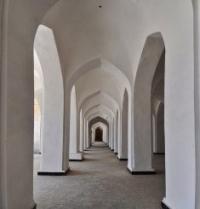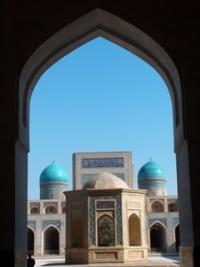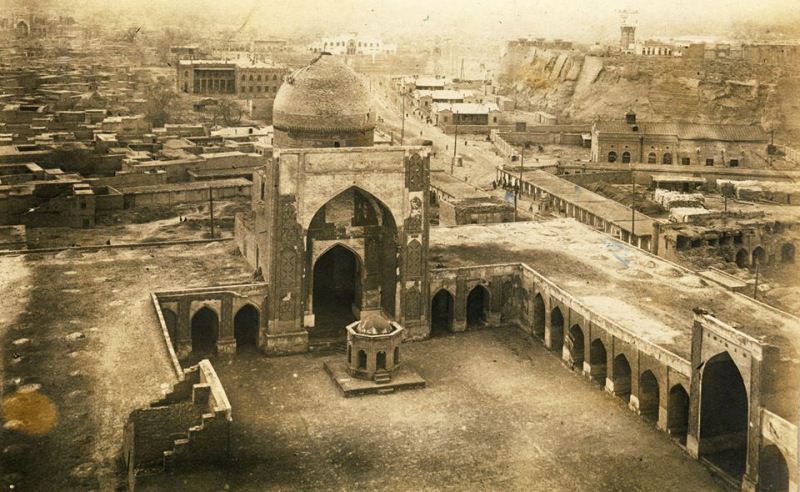Вы здесь
Kalon Mosque in Bukhara.


Architectural places of interest of Bukhara.
“Love is a fateful misfortune, but misfortune is by the will of Allah.
Why do you blame the fact that always - by the will of Allah?
There was both evil and good succession - by the will of Allah,
Why do we need the thunders and flames of the Court by the will of Allah? ”
Omar Khayyam.
Observing excursion to Kalon Mosque in Bukhara.
The paved plaza at the foot of the tower is called Poi-Kalon, 'Pedestal of the Great One' and is flanked by Bukhara's two most imposing facades. One of these, moored by a bridge to the tower, belongs to the Kalon mosque.
(Kalon – big, great) is the main symbol of sacred Bukhara. The minaret was used not only to call Muslims to prayer, but symbolized the authority and power of its spiritual leaders.
Kalon Minaret was built by Karakhanid Arslankhan.
The minaret was totally built of the burnt bricks. The height of the minaret is 46.5 meters. It has 9 meters in diameter at its base. Huge conic thumb is finishing by the cylindrical lamp-rotunda on the stalactite completion.
The lamp has 16 through arched aperture over which there is a stalactite cornice. The inscription on the cornice announces the date of its construction - 1127, and the name of its architect - Bako.
The main eastern entrance of the mosque has a big portal decorated with mosaic. The portal is situated at a raised place and there are several steps leading to the mosque’s courtyard. There are two blue domes at both sides of the mosque.
Kalon Mosque has traditional rectangular form and there are four ayvans. Ayvan at the entrance is decorated with external portal; and with internal portal which is overlooking to the courtyard.
There are arched galleries with 288 domes around the perimeter of the courtyard. They are based on 208 columns. Colored facing of the facades is made from mosaic and glazed bricks.
It is possible to ascend the minaret from the roof of the cathedral mosque through a passage. Inside the tower is a spiral staircase having 105 steps. There is a wonderful view of the whole Bukhara from the rotunda of the minaret.
The central architectural ensemble of Bukhara - Kalon Mosque and Miri Arab Madrasah are situated on the feet of Kalon Minaret. These objects are included into the one complex named Poi-Kalon that means “foot of the minaret”.
First built in the XII century, it was badly damaged by the Mongols and restored in 1514 -1515, according to an inscription under the main entrance arch, by the Sheibanid Ubaydullah Khan with booty from a military campaign the previous year.
A marble plaque on the entrance dated 1541 announces the lifting by his successor Khan Abdulaziz of a tax which may have paid for the mosaic on the mosque's main mikharb. The Kalon mosque is huge, matching Samarkand's Bibi Khanym mosque in scale if not decoration.
A colonnade of 288 cupolas rests on nearly as many columns to form a 127-by 78-m courtyard. At the west end a mighty blue dome called Kok Gumbaz supported a stork's nest until Bukhara's pools were drained and storks stopped migrating here from Egypt.
Colonnade and courtyard between them can hold 10,000 people although the mosque was not used for worship from 1920 to 1989. Non-Muslims may inside. The well under the fourth arch on the left is extremely deep.


Authority:
V.G Saakov «History of Bukhara». Publishing house "Shark", 1996. «Bukhara. Masterpieces of the Central Asia». The historical guidebook across Bukhara. 2012. "Bukhoro. Bukhara" In the Uzbek, English and Russian languages. Publishing house "Uzbekistan", Tashkent 2000. Mukhammad Narkshakhi. History of Bukhara. Tashkent. 1897 (translator N.Lykoshina). V.G.Saakov "Architectural masterpieces of Bukhara. A Bukhara regional society "Kitabhon" Uzbek SSR, Exactly 1991 Robert Almeev. "History of ancient Bukhara". (Under edition of the Academician of the Academy of sciences of Republic Uzbekistan of Rtveladze E.V.).
Photos
Alexander Petrov.







